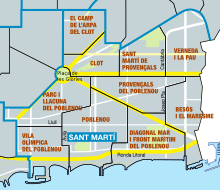Poblenou
Poblenou , also El Poblenou , ( Catalan for New Village ) is a district of the Spanish city of Barcelona .
geography
El Poblenou is part of the municipality of Sant Martí . The district borders in the southwest on the port of Barcelona and in the southeast directly on the open sea .
Expansion of the district
- In the north to Avinguda Diagonal
- In the east to Carrer de Bac de Roda
- In the west to Carrer d'Ávila and Carrer de Pere IV.
- In the south directly to the Mediterranean Sea (with the beach section Platja del Bogatell )
Neighboring district
history
The development of the district in its current size can be traced back to the increasing industrialization around Barcelona in the 18th century. Originally, Poblenou was an independent suburb of the city of Barcelona and not connected to it. Due to the advantageous industrial location by the sea , the district grew rapidly and at the end of the 19th century reached the highest industrial density in all of Spain. Therefore, it was popularly known as El Mànchester Català ('The Catalan Manchester').
The main productions of the local industry were u. a .:
- Oils
- Wine
- textiles
- Metal processing
- gas
- mechanical engineering
- Mosaics
- Graphic art
- Plastics manufacturing and processing
- food
The growing population consisted mainly of immigrant workers. Large residential areas in the Eixample style were laid out for them very early on . Only a few of the original buildings before the industrial era have survived to this day. One of the few remnants of this period is Plaça Prim .
today
Since the 1960s, the industry is increasingly in the commuter belt migrated Barcelona. The former industrial zones with factories and warehouses are increasingly being converted into residential areas with lofts, art galleries, schools, fitness clubs, etc.
With the Olympic Games in Barcelona in 1992 , large parts of the former industry were converted into the Olympic village, the Vila Olímpica . For this purpose, sports parks and around 2000 apartments were created as accommodation for the participating teams.
The @ 22 project, which promotes music, design, architecture and art, serves to further develop the district. The first “superblocks” are also located in Poblenou. Several blocks were combined and declared a car-free zone.
Culture and sights
The former industrial buildings offer various galleries and studios of mostly young local artists.
Like several districts of Barcelona, Poblenou has its own rambla and a market hall. The Rambla Poblenou is largely a traffic-calmed area and stretches from the Gran Via to the Mediterranean Sea.
It attracts a large audience with its various shops and restaurants.
Buildings
When the industrial zones were redesigned, the brick chimneys and certain facades of the factories were carefully preserved. For example at the factory of the German-Cuban manufacturer Emilio Heydrich , Co lores Hispania (1927), or the factory of Valls, Teixidor i Jordana . Today they are under monument protection.
There are also various new buildings worth seeing, such as B. the Hotel ME or the Torre Agbar .
Parks
Between the sea and the residential area there is an approximately 200-meter-wide belt of green spaces that partially “covers” the low-lying Ronda Litoral city motorway . In addition , the Parc del Center del Poblenou designed by Jean Nouvel was laid out together with the Hotel ME . It is located on Avinguda Diagonal and is artistically illuminated at night.
Regular events
A transnational street art festival takes place once a year.
Economy and Infrastructure
traffic
Poblenou is connected to both the metro underground system and the city's tram system . The Poblenou station on metro line 4 is centrally located in the district.
Born in Poblenou
- David Castillo i Buïls (* 1961), writer and journalist
Web links
- Official website of the municipality of Sant Martí (Catalan, Spanish)
- Arxiu Històric del Poblenou Historical Archive of Poblenou. (Catalan)
- Official City Map of Barcelona (English)
Individual evidence
- ↑ El Poblenou . Official website of the City of Barcelona, accessed October 15, 2010. (Catalan, Spanish)
- ↑ 22 @ Barcelona at null-euro-urbanismus.de, accessed on December 28, 2019
- ↑ 22 @ barcelona website , accessed December 28, 2019
- ↑ Project @ 22 & superblocks. In: welovebarcelona.de. Retrieved December 23, 2019 .
- ↑ NIU . Website of a local artists' association, accessed October 15, 2010. (Catalan)
- ↑ BCN Internet ( page no longer available , search in web archives ) Info: The link was automatically marked as defective. Please check the link according to the instructions and then remove this notice. . Tourist information Barcelona, (multilingual). Retrieved October 15, 2010.
- ↑ Colores Hispania | EL ÚLTIMO VIAJE A ICARIA. Retrieved July 21, 2017 (European Spanish).







